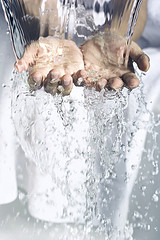AARP Eye Center
You're Making Me Sick (And Other Reasons You Should Wash Your Hands)
By Alejandra Owens, December 7, 2011 09:15 AM

This is a guest post by Annie Lynsen, on loan to AARP from Small Act.
Bless those of you who have strong immune systems, but some of us just aren't that lucky. No matter how careful we are and how many supplements we take, we manage to catch a fair number of colds and flus every year. I am one of those people.
In a new effort to keep illness at bay, I'm becoming much more conscious of what I do with my hands. I've always been good about washing them, but I'm trying to do a better job at keeping them away from my face: I'm trying not to scratch my nose or rub my eyes whenever possible.
This is a good practice for everybody, sick or healthy, particularly if your hands are dirty, if you've just coughed or sneezed into your hands ( which you aren't supposed to do, by the way), or you've just touched a germy surface. Though in any of those cases, it's a good idea to wash your hands as soon as possible.
And speaking of hand washing, this week is National Hand Washing Awareness Week. Here are some tips on hand washing from the Centers for Disease Control and Prevention:
When should you wash your hands?
- Before, during, and after preparing food
- Before eating food
- Before and after caring for someone who is sick
- Before and after treating a cut or wound
- After using the toilet
- After changing diapers or cleaning up a child who has used the toilet
- After blowing your nose, coughing, or sneezing
- After touching an animal, animal feed, or animal waste
- After touching garbage
What is the right way to wash your hands?
- Wet your hands with clean running water (warm or cold) and apply soap.
- Rub your hands together to make a lather and scrub them well; be sure to scrub the backs of your hands, between your fingers, and under your nails.
- Continue rubbing your hands for at least 20 seconds. Need a timer? Hum the "Happy Birthday" song from beginning to end twice.
- Rinse your hands well under running water.
- Dry your hands using a clean towel or air dry.
Washing hands with soap and water is the best way to reduce the number of germs on them. If soap and water are not available, use an alcohol-based hand sanitizer that contains at least 60% alcohol. Alcohol-based hand sanitizers can quickly reduce the number of germs on hands in some situations, but sanitizers do not eliminate all types of germs.
Photo credit: SCA Svenska Cellulosa Aktiebolaget on Flickr























































